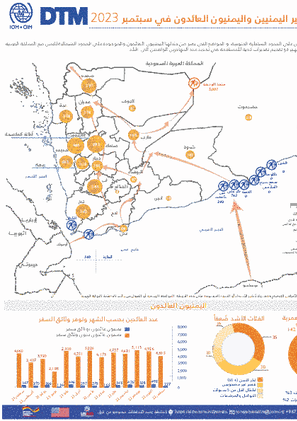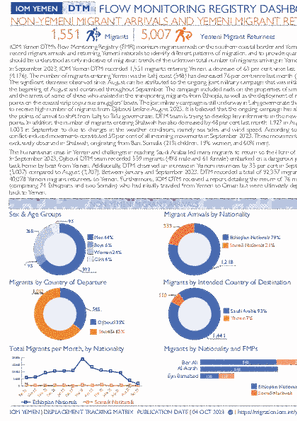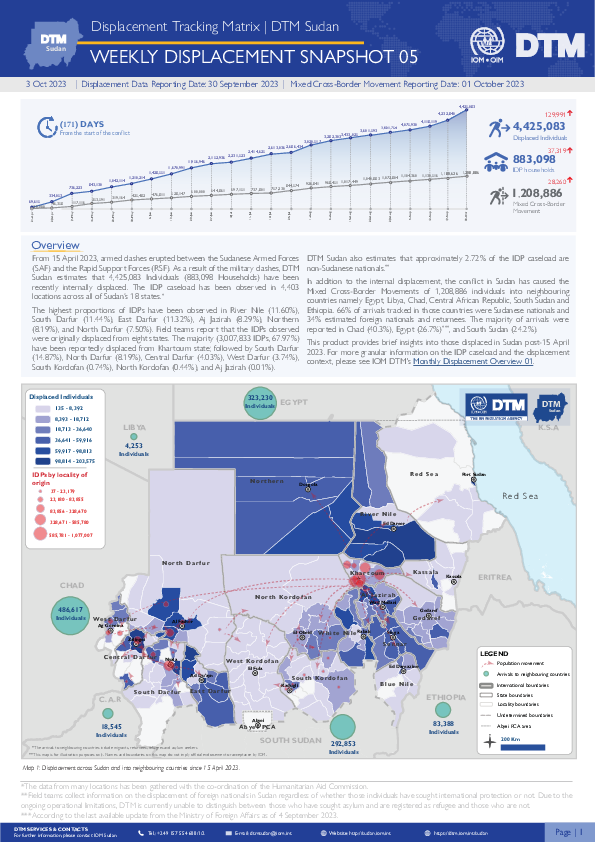-
Countries
-
Data and Analysis
-
Special Focus
-
Crisis Responses

Contact
DTM South Sudan, SouthSudanDTM@iom.int
Language
English
Location
South Sudan
Period Covered
Sep 01 2022
Oct 31 2022
Activity
- Survey
- Return Intention
Between September and October 2022, the International Organization for Migration’s Displacement Tracking Matrix (IOM DTM) undertook its third household-level multi-sector assessment of selected urban areas and camps for internally displaced persons (IDPs) in South Sudan. The assessment aims to:
• Quantify the prevalence of vulnerabilities and humanitarian needs across sectors, with a focus on food security, economic vulnerability and nutrition as well as selected indicators on shelter and non-food items (SNFI), education, health, water, hygiene and sanitation (WASH), protection (including child protection and gender-based violence) and mental health and psycho-social support (MHPSS).
• Generate a better understanding of urban displacement and migration, including return and relocation after displacement in South Sudan or abroad.
There has been slow progress in the humanitarian situation in South Sudan. People’s humanitarian needs continue to rise, driven by cumulative and compounding effects of years of conflict, sub-national violence, food insecurity, climate crisis and public health challenges. Conflict and insecurity, fueled by sub-national and inter-communal violence, crime, and wide-scale impunity, continue to be among the main drivers of humanitarian needs in South Sudan.
Based on the request of the Humanitarian Country Team (HCT), mandated OCHA, IOM, and REACH to implement Inter-Sectoral Needs Assessment that aimed to understand demographics, multi-sectoral needs (including the level of severity) and barriers to assistance as well as displacement patterns and household-level scale.

Contact
DTM South Sudan, SouthSudanDTM@iom.int
Language
English
Location
South Sudan
Period Covered
Sep 01 2022
Oct 31 2023
Activity
- Survey
- Return Intention
Between September and October 2022, the International Organization for Migration’s Displacement Tracking Matrix (IOM DTM) undertook its third household-level multi-sector assessment of selected urban areas and camps for internally displaced persons (IDPs) in South Sudan. The assessment aims to:
• Quantify the prevalence of vulnerabilities and humanitarian needs across sectors, with a focus on food security, economic vulnerability and nutrition as well as selected indicators on shelter and non-food items (SNFI), education, health, water, hygiene and sanitation (WASH), protection (including child protection and gender-based violence) and mental health and psycho-social support (MHPSS).
• Generate a better understanding of urban displacement and migration, including return and relocation after displacement in South Sudan or abroad.
There has been slow progress in the humanitarian situation in South Sudan. People’s humanitarian needs continue to rise, driven by cumulative and compounding effects of years of conflict, sub-national violence, food insecurity, climate crisis and public health challenges. Conflict and insecurity, fueled by sub-national and inter-communal violence, crime, and wide-scale impunity, continue to be among the main drivers of humanitarian needs in South Sudan.
Based on the request of the Humanitarian Country Team (HCT), mandated OCHA, IOM, and REACH to implement Inter-Sectoral Needs Assessment that aimed to understand demographics, multi-sectoral needs (including the level of severity) and barriers to assistance as well as displacement patterns and household-level scale.

Contact
DTM South Sudan, SouthSudanDTM@iom.int
Language
English
Location
South Sudan
Period Covered
Sep 01 2022
Oct 31 2022
Activity
- Survey
- Return Intention
Between September and October 2022, the International Organization for Migration’s Displacement Tracking Matrix (IOM DTM) undertook its third household-level multi-sector assessment of selected urban areas and camps for internally displaced persons (IDPs) in South Sudan. The assessment aims to:
• Quantify the prevalence of vulnerabilities and humanitarian needs across sectors, with a focus on food security, economic vulnerability and nutrition as well as selected indicators on shelter and non-food items (SNFI), education, health, water, hygiene and sanitation (WASH), protection (including child protection and gender-based violence) and mental health and psycho-social support (MHPSS).
• Generate a better understanding of urban displacement and migration, including return and relocation after displacement in South Sudan or abroad.
There has been slow progress in the humanitarian situation in South Sudan. People’s humanitarian needs continue to rise, driven by cumulative and compounding effects of years of conflict, sub-national violence, food insecurity, climate crisis and public health challenges. Conflict and insecurity, fueled by sub-national and inter-communal violence, crime, and wide-scale impunity, continue to be among the main drivers of humanitarian needs in South Sudan.
Based on the request of the Humanitarian Country Team (HCT), mandated OCHA, IOM, and REACH to implement Inter-Sectoral Needs Assessment that aimed to understand demographics, multi-sectoral needs (including the level of severity) and barriers to assistance as well as displacement patterns and household-level scale.

Contact
DTM South Sudan, SouthSudanDTM@iom.int
Language
English
Location
South Sudan
Period Covered
Sep 01 2022
Oct 31 2022
Activity
- Survey
- Return Intention
Between September and October 2022, the International Organization for Migration’s Displacement Tracking Matrix (IOM DTM) undertook its third household-level multi-sector assessment of selected urban areas and camps for internally displaced persons (IDPs) in South Sudan. The assessment aims to:
• Quantify the prevalence of vulnerabilities and humanitarian needs across sectors, with a focus on food security, economic vulnerability and nutrition as well as selected indicators on shelter and non-food items (SNFI), education, health, water, hygiene and sanitation (WASH), protection (including child protection and gender-based violence) and mental health and psycho-social support (MHPSS).
• Generate a better understanding of urban displacement and migration, including return and relocation after displacement in South Sudan or abroad.
There has been slow progress in the humanitarian situation in South Sudan. People’s humanitarian needs continue to rise, driven by cumulative and compounding effects of years of conflict, sub-national violence, food insecurity, climate crisis and public health challenges. Conflict and insecurity, fueled by sub-national and inter-communal violence, crime, and wide-scale impunity, continue to be among the main drivers of humanitarian needs in South Sudan.
Based on the request of the Humanitarian Country Team (HCT), mandated OCHA, IOM, and REACH to implement Inter-Sectoral Needs Assessment that aimed to understand demographics, multi-sectoral needs (including the level of severity) and barriers to assistance as well as displacement patterns and household-level scale.
Contact
iomyemendtm@iom.int
Location
Yemen
Activity
- Flow Monitoring Survey
- Flow Monitoring
Period Covered
Sep 01 2023 -Sep 30 2023
In September 2023, IOM Yemen DTM recorded 1,551 migrants entering Yemen, a decrease of 63 per cent since last month (4,176). The number of migrants entering Yemen via the Lahj coast (548) has decreased 76 per cent since last month (2,249). The significant decrease observed since August can be attributed to the ongoing joint military campaign that was initiated at the beginning of August and continued throughout September. The campaign included raids on the properties of smugglers and the arrest of some of these who assisted in the transporting migrants from Ethiopia, as well as the deployment of military points on the coastal strip to pursue smugglers' boats. The join military campaign is still underway in Lahj governorate that used to receive high number of migrants from Djibouti before August 2023. It is believed that the ongoing campaign has affected the points of arrival to shift from Lahj to Ta'iz governorate. DTM team is trying to develop key informants in the new arrival points. In addition, the number of migrants entering Shabwah has also decreased by 48 per cent last month 1,927 in August to 1,003 in September to due to changes in the weather conditions, namely sea tides and wind speed. According to DTM, conflict-induced movements constituted 50 per cent of all incoming movements in September 2023. These movements were exclusively observed in Shabwah, originating from Bari, Somalia (21% children, 19% women, and 60% men).
The humanitarian crisis in Yemen and challenges in reaching Saudi Arabia led many migrants to return to the Horn of Africa. In September 2023, Djibouti DTM team recorded 559 migrants (498 male and 61 female) embarked on a dangerous journey back home by boat from Yemen. Additionally, DTM observed an increase in Yemeni returnees by 35 per cent in September (5,007) compared to August (3,707).
Between January and September 2023, DTM recorded a total of 92,357 migrants and 40,078 Yemeni migrant returnees to Yemen. Furthermore, IOM DTM received a report detailing the return of 76 migrants (comprising 74 Ethiopians and two Somalis) who had initially traveled from Yemen to Oman but were ultimately deported back to Yemen.
Population Groups
Survey Methodology
Unit of Analysis Or Observation
Type of Survey or Assessment
Keywords
Geographical Scope
Administrative boundaries with available data
The current dataset covers the following administrative boundaries

Contact
IOM DTM Yemen, iomyemendtm@iom.int
Language
English
Location
Yemen
Period Covered
Sep 01 2023
Sep 30 2023
Activity
- Flow Monitoring
في سبتمبر 2023، سجلت مصفوفة تتبع النزوح التابعة للمنظمة الدولية للهجرة في اليمن دخول 1,551 مهاجرًا إلى اليمن، بانخفاض قدره 63 بالمائة منذ الشهر الماضي (4,176). وانخفض عدد المهاجرين الذين يدخلون اليمن عبر ساحل لحج (548) بنسبة 76 في المائة منذ الشهر الماضي (2249). ويمكن أن يعزى الانخفاض الكبير الملحوظ منذ شهر أغسطس إلى الحملة العسكرية المشتركة المستمرة التي بدأت في بداية شهر أغسطس واستمرت طوال شهر سبتمبر. وتضمنت الحملة مداهمة ممتلكات المهربين واعتقال عدد منهم الذين ساعدوا في نقل المهاجرين من إثيوبيا، فضلاً عن نشر نقاط عسكرية على الشريط الساحلي لملاحقة قوارب المهربين. ولا تزال الحملة العسكرية المشتركة مستمرة في محافظة لحج التي كانت تستقبل أعداداً كبيرة من المهاجرين من جيبوتي قبل أغسطس 2023. ويعتقد أن الحملة المستمرة أثرت على نقاط الوصول للانتقال من لحج إلى محافظة تعز. يحاول فريق مصفوفة تتبع النزوح تطوير المخبرين الرئيسيين في نقاط الوصول الجديدة. بالإضافة إلى ذلك، انخفض أيضًا عدد المهاجرين الذين يدخلون شبوة بنسبة 48 بالمائة الشهر الماضي من 1,927 في أغسطس إلى 1,003 في سبتمبر، وذلك بسبب التغيرات في الظروف الجوية، وتحديداً المد البحري وسرعة الرياح. وفقًا لمصفوفة تتبع النزوح، شكلت الحركات الناجمة عن النزاع 50% من جميع الحركات الواردة في سبتمبر 2023. وقد لوحظت هذه الحركات حصريًا في شبوة، مصدرها باري بالصومال (21% أطفال، 19% نساء، و60% رجال).
أدت الأزمة الإنسانية في اليمن وتحديات الوصول إلى المملكة العربية السعودية إلى عودة العديد من المهاجرين إلى القرن الأفريقي. في سبتمبر 2023، سجل فريق مصفوفة تتبع النزوح في جيبوتي أن 559 مهاجرًا (498 ذكر و61 أنثى) انطلقوا في رحلة خطيرة للعودة إلى وطنهم بالقارب من اليمن. بالإضافة إلى ذلك، لاحظت مصفوفة تتبع النزوح زيادة في عدد العائدين اليمنيين (35%) في سبتمبر (5,007) مقارنة بشهر أغسطس (3,707). بين يناير وسبتمبر 2023، سجلت مصفوفة تتبع النزوح إجمالي 92,357 مهاجرًا و40,078 مهاجرًا يمنيًا عائدًا إلى اليمن. علاوة على ذلك، تلقت مصفوفة تتبع النزوح التابعة للمنظمة الدولية للهجرة تقريرا مفصلا عن عودة 76 مهاجرا (من بينهم 74 إثيوبيا وصوماليين اثنين) كانوا قد سافروا في البداية من اليمن إلى عمان ولكن تم ترحيلهم في النهاية إلى اليمن.

Contact
IOM DTM Yemen, iomyemendtm@iom.int
Language
English
Location
Yemen
Period Covered
Sep 01 2023
Sep 30 2023
Activity
- Flow Monitoring
In September 2023, IOM Yemen DTM recorded 1,551 migrants entering Yemen, a decrease of 63 per cent since last month (4,176). The number of migrants entering Yemen via the Lahj coast (548) has decreased 76 per cent since last month (2,249). The significant decrease observed since August can be attributed to the ongoing joint military campaign that was initiated at the beginning of August and continued throughout September.. The campaign included raids on the properties of smugglers and the arrest of some of these who assisted in the transporting migrants from Ethiopia, as well as the deployment of military points on the coastal strip to pursue smugglers' boats. The join military campaign is still underway in Lahj governorate that used to receive high number of migrants from Djibouti before August 2023. It is believed that the ongoing campaign has affected the points of arrival to shift from Lahj to Ta'iz governorate. DTM team is trying to develop key informants in the new arrival points. In addition, the number of migrants entering Shabwah has also decreased by 48 per cent last month 1,927 in August to 1,003 in September to due to changes in the weather conditions, namely sea tides and wind speed. According to DTM, conflict-induced movements constituted 50 per cent of all incoming movements in September 2023. These movements were exclusively observed in Shabwah, originating from Bari, Somalia (21% children, 19% women, and 60% men).
The humanitarian crisis in Yemen and challenges in reaching Saudi Arabia led many migrants to return to the Horn of Africa. In September 2023, Djibouti DTM team recorded 559 migrants (498 male and 61 female) embarked on a dangerous journey back home by boat from Yemen. Additionally, DTM observed an increase in Yemeni returnees by 35 per cent in September (5,007) compared to August (3,707). Between January and September 2023, DTM recorded a total of 92,357 migrants and 40,078 Yemeni migrant returnees to Yemen. Furthermore, IOM DTM received a report detailing the return of 76 migrants (comprising 74 Ethiopians and two Somalis) who had initially traveled from Yemen to Oman but were ultimately deported back to Yemen.

Contact
DTM Sudan, DTMSudan@iom.int
Language
English
Location
Sudan
Snapshot Date
Sep 30 2023
Activity
- Mobility Tracking
- Baseline Assessment
From 15 April 2023, armed clashes erupted between the Sudanese Armed Forces (SAF) and the Rapid Support Forces (RSF). As a result of the military clashes, DTM Sudan estimates that 4,425,083 Individuals (883,098 Households) have been recently internally displaced. The IDP caseload has been observed in 4,403 locations across all of Sudan’s 18 states.
The highest proportions of IDPs have been observed in River Nile (11.60%), South Darfur (11.44%), East Darfur (11.32%), Aj Jazirah (8.29%), Northern (8.19%), and North Darfur (7.50%). Field teams report that the IDPs observed were originally displaced from eight states. The majority (3,007,833 IDPs, 67.97%) have been reportedly displaced from Khartoum state; followed by South Darfur (14.87%), North Darfur (8.19%), Central Darfur (4.03%), West Darfur (3.74%), South Kordofan (0.74%), North Kordofan (0.44%), and Aj Jazirah (0.01%). DTM Sudan also estimates that approximately 2.72% of the IDP caseload are non-Sudanese nationals.
In addition to the internal displacement, the conflict in Sudan has caused the Mixed Cross-Border Movements of 1,208,886 individuals into neighbouring countries namely Egypt, Libya, Chad, Central African Republic, South Sudan and Ethiopia. 66% of arrivals tracked in those countries were Sudanese nationals and 34% estimated foreign nationals and returnees. The majority of arrivals were reported in Chad (40.3%), Egypt (26.7%), and South Sudan (24.2%).
This product provides brief insights into those displaced in Sudan post-15 April 2023. For more granular information on the IDP caseload and the displacement context, please see IOM DTM's Monthly Displacement Overview 01.
Contact
DTM Burundi, DTMBurundi@iom.int
Location
Burundi
Activity
- Mobility Tracking
- Event Tracking
Period Covered
Sep 23 2023 -Sep 30 2023
Du 24 au 30 septembre 2023, la DTM a identifié 2 878 personnes affectées (519 ménages) dont 190 personnes déplacées (48 ménages) par les pluies torrentielles et les vents violents dans les provinces de Makamba, Ngozi et Cibitoke.
Population Groups
Survey Methodology
Unit of Analysis Or Observation
Type of Survey or Assessment
Keywords
Geographical Scope
Administrative boundaries with available data
The current dataset covers the following administrative boundaries

